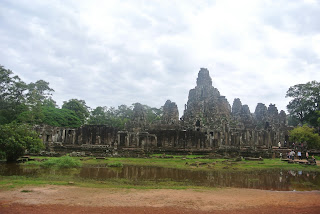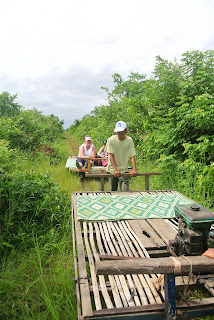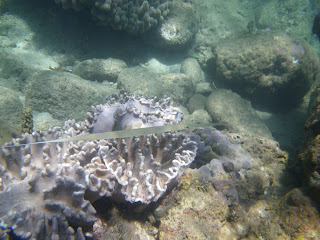By the time I have finished exploring the Angkor complex I still have a week until I am due to meet Alex for our flight from Kuala Lumpur to Kota Kinabalu, on Malaysian Borneo. I consider exploring more of Cambodia, but I decide that I could do with a few days of relaxing on Koh Tao before I start travelling again. I feel slightly guilty about shirking my travelling duties in favour of waking up in the same place three nights running, but not for too long.
After only a few short bus rides, one ferry and a few hours in Bangkok inbetween, I arrive on Koh Tao just 28 hours after I left Siem Reap in Cambodia. Alex has finished her dive masters and spends the last few days on the island getting in as much free diving as she can. I only dive a few times (I have to pay) and spend most of my time sunbathing, sleeping in, reading and eating. Tough I know, but despite having wanted a break I'm bored after a couple of days and eager to start travelling again.
Our fight to Borneo leaves from Kuala Lumpur in Malaysia. To get there we have to take a night ferry (very narrow matresses on the floor of is probably a fishing boat in its spare time) from Koh Tao to the main land , two cramped mini buses to get to Penang in Malaysia and from Penang a coach to Kuala Lumpur. We arrive at two in the morning - two days after we left Koh Tao. I genuinely hadn't anticipated so much actual travelling when I decided to go 'travelling'.
Kuala Lumpur reminds me of an ant farm - there are pavements and walk ways and fly overs and bridges and train tracks everywhere, on every level, in every direction and all along them file people, trains and cars as fast as they can go.
Because we will be back in a few weeks to get our visas for Myanmar we don't do any sight seeing in KL (although I do glimpse the Petronas Towers between buildings). Instead we spend our day in Kuala Lumpur repacking our bags, throwing worn out clothes away, stocking up on toiletries and, most excitingly, booking various permits for diving and climbing on Borneo - mountains, jungles, orangutans, snorkelling, river boats; I can't wait!
After only a few short bus rides, one ferry and a few hours in Bangkok inbetween, I arrive on Koh Tao just 28 hours after I left Siem Reap in Cambodia. Alex has finished her dive masters and spends the last few days on the island getting in as much free diving as she can. I only dive a few times (I have to pay) and spend most of my time sunbathing, sleeping in, reading and eating. Tough I know, but despite having wanted a break I'm bored after a couple of days and eager to start travelling again.
Our fight to Borneo leaves from Kuala Lumpur in Malaysia. To get there we have to take a night ferry (very narrow matresses on the floor of is probably a fishing boat in its spare time) from Koh Tao to the main land , two cramped mini buses to get to Penang in Malaysia and from Penang a coach to Kuala Lumpur. We arrive at two in the morning - two days after we left Koh Tao. I genuinely hadn't anticipated so much actual travelling when I decided to go 'travelling'.
Kuala Lumpur reminds me of an ant farm - there are pavements and walk ways and fly overs and bridges and train tracks everywhere, on every level, in every direction and all along them file people, trains and cars as fast as they can go.
Because we will be back in a few weeks to get our visas for Myanmar we don't do any sight seeing in KL (although I do glimpse the Petronas Towers between buildings). Instead we spend our day in Kuala Lumpur repacking our bags, throwing worn out clothes away, stocking up on toiletries and, most excitingly, booking various permits for diving and climbing on Borneo - mountains, jungles, orangutans, snorkelling, river boats; I can't wait!









































